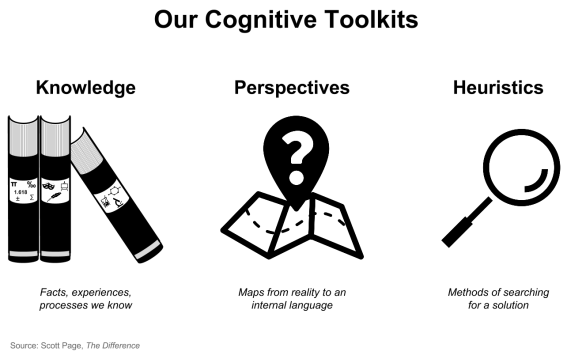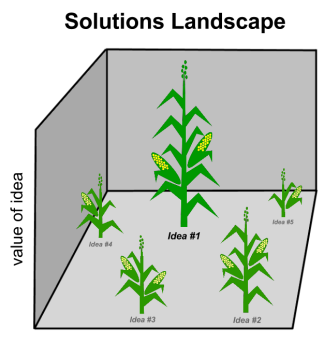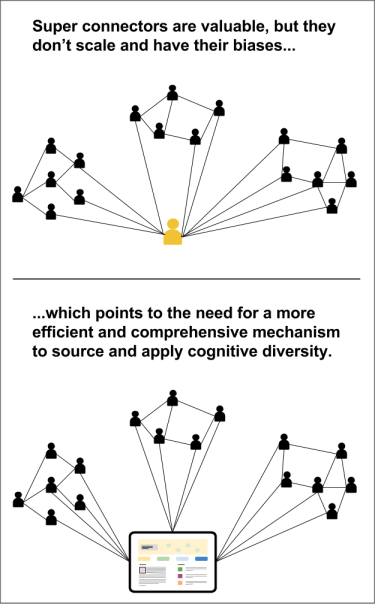10 examples that show the value of cognitive diversity
July 30, 2015 3 Comments
In a previous post, the benefits of crowdsourcing were described as follows:
When trying to solve a challenge, what is the probability that any one person will have the best solution for it? It’s a simple mathematical reality: the odds of any single person providing the top answer are low.
How do we get around this? Partly by more participants; increased shots on goal. But even more important is diversity of thinking. People contributing based on their diverse cognitive toolkits
Cognitive diversity is a vital contributor to innovation. Bringing together people who have different expertise, heuristics and perspectives to solve problems has shown value time and again. Professor Scott Page’s The Difference is a terrific book outlining the frameworks and value of cognitive diversity.
I thought it would be useful to collect some cases that highlight the value of cognitive diversity. The theories are powerful, but we respond strongly to specific examples. Collected below are ten cases of where cognitive diversity has shown its value. Feel free to use them for your own work as needed.
1. The mystery of our kidney tubules
Problem: Human kidneys have tubules. For years, they were assumed to be leftover, useless artifacts of our natural evolution. Hence physiologists assumed they had no purpose. Meaning their care and study could be safely ignored.
How diversity helped: One day, an engineer looked at the loops. He saw something different. He realized they were actually part of something called a countercurrent multiplier. These mechanisms concentrate liquids in a system. Suddenly, tubules were no longer evolution’s leftover junk. They were seen for what they were: vital parts of our kidneys’ operations.
An engineer with no special biological expertise saw things in a total different way.
Reference: Edward de Bono’s Lateral Thinking: An Introduction
2. Why this particular pathology in a drug discovery trial?
Problem: A pharmaceutical company’s R&D group was conducting a discovery study for a new drug. They couldn’t understand the toxicological significance of a particular observed pathology. They consulted with multiple experts in toxicology, but none could answer the question.
How diversity helped: The pharma firm then ran a crowdsourcing campaign, and within a few the mystery was solved. The solver? A woman with a PhD in protein crystallography using methods common in her field. An area unrelated to toxicology.
The woman with the PhD brought a completely different perspective to solving the problem.
Reference: Harvard Business School, et al study, The Value of Openness in Scientific Problem Solving (page 11 pdf)
3. Who has a higher probability to solve a problem?
Problem: People with expertise in a particular domain are challenged to provide workable solutions to tough problems. But these are the ones we regularly turn to for help.
How diversity helped: Researchers analyzed the outcomes of InnoCentive’s crowdsourcing challenges. What they found was surprising. For each challenge, they identified the domain of the problem. They then looked at the winning solvers. What were their domains of expertise? They found that people whose domain of expertise was six degrees away from the domain of the problem were three times likelier to solve the problem.
Getting people who are outside the domain of the problem provides higher odds of finding the best solution to a problem.
Reference: Harvard Business School, et al study, The Value of Openness in Scientific Problem Solving (page 24 pdf)
4. Stop new diamond fractures from happening
Problem: In the process of cutting diamonds, new fractures are introduced into the diamond. These fractures don’t show up until the diamond is in use. Manufacturers wanted to split diamonds along their natural fractures without creating new ones. But didn’t know how.
How diversity helped: This is a case of investigators consciously looking at different realms to find a solution, applying the TRIZ method. The solution came in an area quite different than diamonds: green peppers. Food companies need to split the peppers and remove their seeds. Peppers are placed in a chamber to which air pressure is increased significantly. The peppers shrink and fracture at the stem. Then the pressure is rapidly dropped causing them to burst at the weakest point and the seed pod to be ejected. A similar technique applied to diamond cutting resulted in the crystals splitting along their natural fracture lines with no additional damage.
This is an example of consciously seeking solutions outside the domain of the problem. Which is the crux of cognitive diversity.
Reference: QFD Institute, TRIZ workshop
5. Reducing surgery infections
Problem: Surgery exposes patients to infections, even with all the efforts to maintain a clean surgical environment. Reducing these infections would result in better outcomes for patients.
How diversity helped: 3M brought together people from three different areas: an expert in wound healing; an animal surgeon; and a specialist in theatrical makeup with expertise in adhering materials to skin. They developed a breakthrough product to prevent surgical infections.
While the wound specialist is consistent with what we’d expect, the makeup artist inclusion was quite different. She brought a particular expertise that turned out to be relevant to solving the problem.
Reference: Eric von Hippel, et al, Performance Assessment of the Lead User Idea Generation Process (pdf)
6. How to really help the homeless?
Problem: Homelessness has proven to be an intractable, chronic issue for cities. Municipalities spend money on treatment, overnight shelter, food. But the issue has vexed city officials everywhere.
How diversity helped: Sam Tsemberis is a psychologist. His training was to treat the mental health of people. He took a job to treat homeless people in the early 1990s. Not to solve homelessness, with its complex set of causes. Just to treat individuals, which fit his expertise. However, he saw things differently with the homeless. They operated in a set of complex circumstances. He felt the dominant thinking of experts in the homeless field was wrong, that homeless people are quite resourceful.
Lacking any prior experience in solving the homeless issue, Tsemberis assembled a team of people who also lacked any experience in addressing homelessness at scale. One was a recovering heroin addict. Another was a formerly homeless person. Another was a psychologist. And the last, Hilary Melton, was a poet and a survivor of incest.
Their solution? Giving permanent housing to the homeless. And it has proven remarkably successful thus far. Utah employed the method, and eliminated homelessness. Phoenix applied it and eliminated chronic homelessness among veterans.
Fresh eyes came up with a solution that challenged the dominant thinking in the field.
Reference: Washington Post, Meet the outsider who accidentally solved chronic homelessness
7. Predicting solar particle storms
Problem: When in space, astronauts are at risk from solar particle storms. Knowing when these storms are going to happen is important for their safety. However, NASA had spent 30 years unsuccessfully trying to figure out how to predict these storms.
How diversity helped: NASA cast a challenge on InnoCentive, exposing the problem to much broader types of expertise. And they received a solution much better than anything they had ever developed. A retired telecommunications engineer in New Hampshire saw the issue as one involved magnetic coupling between the sun and the Earth.
The solver was not in the space field. He had no connection to NASA. He was located far from NASA operations. His fresh perspective brought new insight to the problem.
Reference: Forbes India, The importance of diversity of thought for solving wicked problems
8. Who starts billion dollar companies?
Problem: What is the ‘look’ of success in start-ups? Certainly understanding these characteristics could go a long way toward identifying promising ventures.
How diversity helped: Shasta Ventures ran an analysis of 32 companies that are high flyers, including Uber, Twitter, Dropbox, Twitch, etc. They looked at the companies way back when they were raising their Series A. They found a few different traits. One that stands out:
Three-out-of-four of the companies in our survey were built and run by people who were doing it for the first time. They did not have a win under their belt or deep experience in their field, but were passionate about their product and had a unique perspective on how to serve their target customer. Having a fresh perspective is important in tackling a category as people with industry experience are often constrained by what is ‘not possible’ and why it ‘won’t work’.
Shasta notes here what others have found. People get stuck in knowing what they know. Innovation benefits from fresh perspectives.
Reference: Tod Francis, Shasta Ventures, What did Billion Dollar Companies Look Like at the Series A?
9. Stopping a key enzyme that powers the AIDS virus
Problem: For a decade, scientists have tried to understand the structure of an enzyme that is critical to reproduction of the AIDS virus. If they could finally figure out the structure, that would allow them to develop drugs to fight AIDS.
How diversity helped: Researchers added the AIDS reproduction enzyme structure to the online game FoldIt. In FoldIt, players try their hand at folding various proteins. Proteins are core building blocks, and they fold in very specific ways. Scientists have a hard time replicating the folding sequence; researchers started FoldIt to see how amateurs could do at replicating the folding.
In this case, insights about the enzyme’s folding were provided by FoldIt gamers (not scientific experts) within three weeks. Their strategies were instrumental in helping scientists to understand the enzyme, and initiate work to neutralize it.
Reference: Scientific American, Foldit Gamers Solve Riddle of HIV Enzyme within 3 Weeks
10. Auto-Tune to…ahem…enhance recordings
Problem: Music producers spent significant time putting together music from multiple takes. The process was laborious, but needed to ensure high quality recordings for release. Humans inevitably had inconsistencies, either in voice or instruments.
How diversity helped: Exxon engineer Andy Hildebrand had spent 18 years working in seismic data exploration. He developed a technique using a mathematical model called autocorrelation. His approach involved sending sound waves into the ground and then recording their reflections.
It turns out autocorrelation is also good for detecting pitch in music as well. Hildebrand, who had taken some music classes, recognized an opportunity to improve the quality of music. He introduced Auto-Tune to the industry. And the rest is history.
In this case, knowledge from one industry – oil exploration – was applied to an entirely different field – music. The cognitive diversity was a conscious application of expertise from one realm to another.
Reference: New Yorker Magazine, The Gerbil’s Revenge
While the most natural human tendency is to depend on those we know with expertise in a given, the preceding examples show the value of getting fresh perspectives. When everyone “knows what we know”, it’s time to expand your options.
I’m @bhc3 on Twitter.






The Conversation